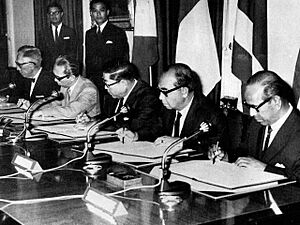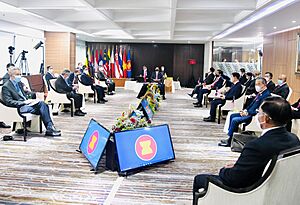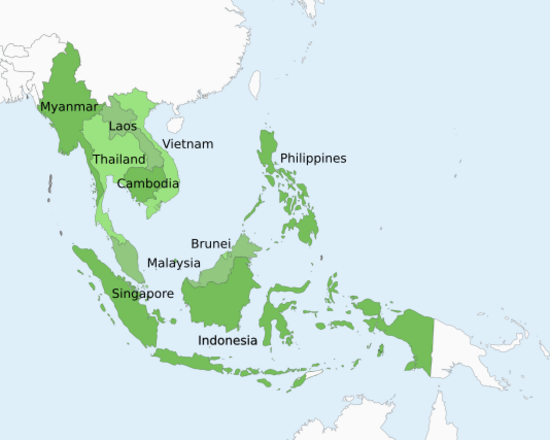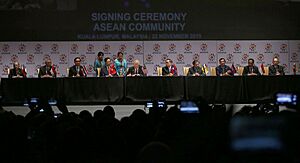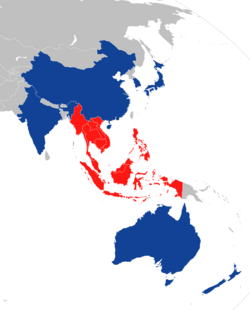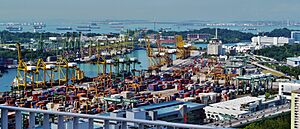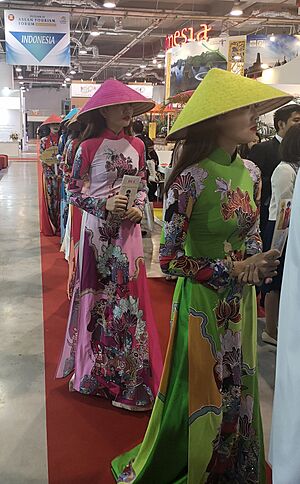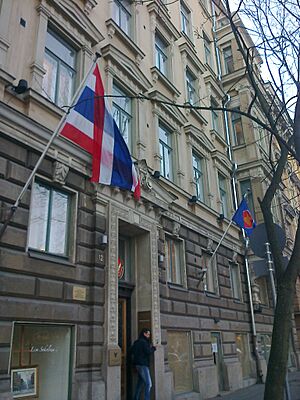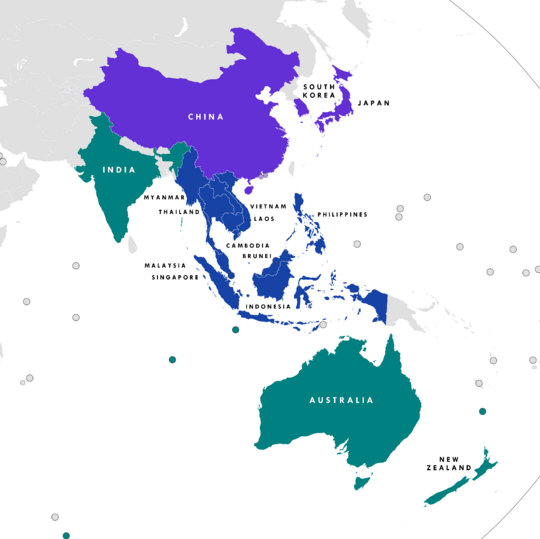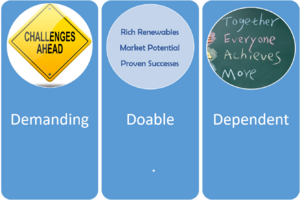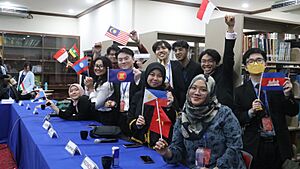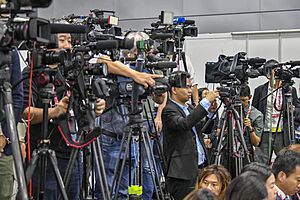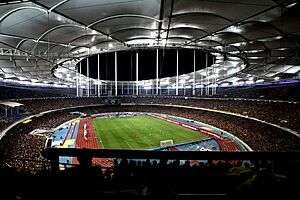ASEAN facts for kids
Quick facts for kids
Association of Southeast Asian Nations
|
|||||||||||||||||||||||||
|---|---|---|---|---|---|---|---|---|---|---|---|---|---|---|---|---|---|---|---|---|---|---|---|---|---|
|
Motto: "One Vision, One Identity, One Community"
|
|||||||||||||||||||||||||
|
Anthem: "The ASEAN Way"
|
|||||||||||||||||||||||||
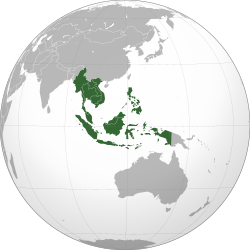
Member states shown in dark green
|
|||||||||||||||||||||||||
| Headquarters | Jakarta, Indonesia 6°14′20″S 106°47′57″E / 6.23889°S 106.79917°E |
||||||||||||||||||||||||
| Largest city | Jakarta, Indonesia | ||||||||||||||||||||||||
| Working language | English |
||||||||||||||||||||||||
| Other languages | |||||||||||||||||||||||||
| Type | Regional organisation | ||||||||||||||||||||||||
| Membership |
11 members
1 observer
|
||||||||||||||||||||||||
| Leaders | |||||||||||||||||||||||||
|
• Chairman
|
Anwar Ibrahim (Malaysia) |
||||||||||||||||||||||||
|
• Secretary-General
|
Kao Kim Hourn (Cambodia) |
||||||||||||||||||||||||
| Legislature | The ASEAN Inter-Parliamentary Assembly | ||||||||||||||||||||||||
| Establishment | |||||||||||||||||||||||||
|
• Bangkok Declaration
|
8 August 1967 | ||||||||||||||||||||||||
|
• Charter
|
16 December 2008 | ||||||||||||||||||||||||
| Area | |||||||||||||||||||||||||
|
• Total
|
4,522,518 km2 (1,746,154 sq mi) | ||||||||||||||||||||||||
| Population | |||||||||||||||||||||||||
|
• 2023 estimate
|
683,290,000 | ||||||||||||||||||||||||
|
• Density
|
144/km2 (373.0/sq mi) | ||||||||||||||||||||||||
| GDP (PPP) | 2025 estimate | ||||||||||||||||||||||||
|
• Total
|
|||||||||||||||||||||||||
|
• Per capita
|
|||||||||||||||||||||||||
| GDP (nominal) | 2025 estimate | ||||||||||||||||||||||||
|
• Total
|
|||||||||||||||||||||||||
|
• Per capita
|
|||||||||||||||||||||||||
| HDI (2023) | high |
||||||||||||||||||||||||
| Time zone | UTC+06:30 to +09:00 | ||||||||||||||||||||||||
|
|||||||||||||||||||||||||
The Association of Southeast Asian Nations, often called ASEAN, is a special group of 11 countries in Southeast Asia. These countries work together to help each other grow economically and stay safe. Imagine them as a team, helping each other succeed!
More than 600 million people live in ASEAN countries. Their total land area is huge, over 4.5 million square kilometers. Together, they form one of the world's fastest-growing economic areas. ASEAN is very important for the whole East Asia region.
ASEAN's main goals are to make the region grow faster in terms of economy, social life, and culture. They also want to keep peace and stability. They do this by respecting fairness and laws, following the rules of the United Nations.
The current leader of ASEAN, called the Secretary-General, is Kao Kim Hourn. This year, Malaysia is the chairman, led by Prime Minister Anwar Ibrahim.
ASEAN also works with many other groups and countries around the world. It's a big partner with the United Nations and other important organizations. This helps ASEAN countries build strong friendships and work together on global issues. ASEAN's success has even inspired other large trade groups like APEC.
Contents
- History of ASEAN: How It Started and Grew
- ASEAN Member Countries
- People and Cities in ASEAN
- The ASEAN Way: How Countries Work Together
- How ASEAN is Organized
- ASEAN's Economy
- ASEAN's Global Connections
- Protecting the Environment in ASEAN
- Education and Learning in ASEAN
- Culture and Arts in ASEAN
- Security and Safety in ASEAN
- Images for kids
- See also
History of ASEAN: How It Started and Grew
Early Influences on Southeast Asia
Southeast Asian countries are located in a very important place. They are a bridge between East Asia and South Asia, near busy trade routes in the South China Sea and Indian Ocean. Because of this, they have been influenced by many cultures, including Islamic and Persian ideas, long before Europeans arrived.
For thousands of years, this region was a hub for trade. This brought new ideas and writing systems. For example, different types of scripts were used to write languages like Old Malay.
Later, many European countries came and took control of most of these lands. This is called European colonialism. Countries like Vietnam, Laos, Cambodia, Myanmar, Malaysia, Singapore, Brunei, Indonesia, Philippines, and Timor-Leste were once colonies. Only Thailand managed to stay independent, acting as a buffer between British and French colonies. During this time, European religions, technologies, and the Latin alphabet were introduced.
During World War II, Japan tried to unite Asian countries against Western control. However, Japan's role in the war changed things. After the war, many Southeast Asian countries fought for and gained their independence. This led to the independent nations we see in ASEAN today.
The Formation of ASEAN
Before ASEAN, there was a group called the Association of Southeast Asia (ASA), started in 1961 by Thailand, the Philippines, and Malaya.
ASEAN itself began on August 8, 1967. Five countries—Indonesia, Malaysia, the Philippines, Singapore, and Thailand—signed an important paper called the ASEAN Declaration in Bangkok. This declaration stated that ASEAN would work to speed up economic growth, social progress, and cultural development. They also wanted to keep peace and stability in the region.
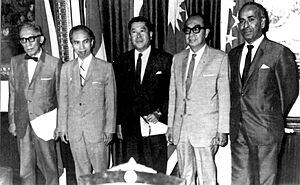
At first, ASEAN was formed to help countries work together against political challenges after World War II. They wanted to ensure peace and prevent conflicts from spreading.
ASEAN held its first big meeting, called a summit, in Bali, Indonesia, in 1976. Here, they agreed on projects and signed a Treaty of Amity and Cooperation. This treaty helped build friendships and cooperation. As time went on, especially in the 1990s, ASEAN became a strong voice for trade and safety in the region.
In 1995, ASEAN countries signed a special treaty to make Southeast Asia a nuclear-weapon-free zone. This means no nuclear weapons are allowed in the region, helping to keep everyone safe.
ASEAN's Growth and New Members
Over the years, more countries joined the ASEAN family.
- In 1984, Brunei became the sixth member.
- In 1995, Vietnam joined.
- In 1997, Laos and Myanmar became members.
- Cambodia joined in 1999 after some internal challenges were resolved.
- Most recently, Timor-Leste joined ASEAN on October 26, 2025.
ASEAN also gained a special "observer status" at the United Nations General Assembly in 2006. This means ASEAN can attend UN meetings and share its views. In return, the UN became a "dialogue partner" with ASEAN, meaning they talk and work together.
The ASEAN Charter: A Rulebook for Cooperation
In 2008, ASEAN countries launched the ASEAN Charter. This important document made ASEAN a legal organization, like a country has a constitution. The goal was to create a stronger community, similar to how countries in the European Union work together. The charter aimed to create a single market for trade, connecting over 500 million people.
The charter also led to the creation of the ASEAN Intergovernmental Commission on Human Rights (AICHR) in 2009. This group works to promote and protect human rights in the region. In 2012, they adopted the ASEAN Human Rights Declaration.
The leadership of ASEAN changes each year. A different member country takes on the role of chairman. Malaysia is the chairman for 2025.
| Year | Country |
|---|---|
| 2008 | |
| 2009 | |
| 2010 | |
| 2011 | |
| 2012 | |
| 2013 | |
| 2014 | |
| 2015 | |
| 2016 | |
| 2017 | |
| 2018 | |
| 2019 | |
| 2020 | |
| 2021 | |
| 2022 | |
| 2023 | |
| 2024 | |
| 2025 |
ASEAN's Response to Health Challenges
ASEAN works together to protect people's health, especially during widespread sicknesses like pandemics. They cooperate with other countries to create quick and effective responses.
Working Together During SARS
During the SARS outbreak, ASEAN and its partners worked to share information and best practices. They also improved health checks for travelers to stop the disease from spreading.
Responding to the H1N1 Pandemic
In 2009, ASEAN health ministers met to discuss the H1N1 pandemic. They set up hotlines for health authorities and formed joint teams to respond to the virus. They also boosted research efforts.
Addressing Challenges in Myanmar
Since 2017, political and social situations in Myanmar have created challenges for ASEAN. These events have tested ASEAN's traditions of unity and cooperation.
Challenges for the Rohingya People
In 2017, a difficult situation involving the Rohingya people in Myanmar caused many to leave their homes. This led to global concern, and ASEAN worked to address the challenges and help find solutions.
Political Changes in 2021
In February 2021, there were significant political changes in Myanmar. A military government took control, leading to protests and resistance. ASEAN faced pressure to act and worked to find a peaceful way forward for the region.
ASEAN Member Countries
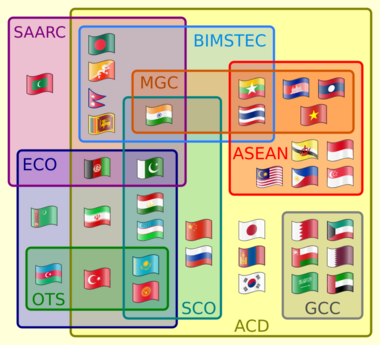
List of Member States
Here are the countries that are part of ASEAN:
| State | Accession |
|---|---|
| January 7, 1984 | |
| April 30, 1999 | |
| August 8, 1967 | |
| July 23, 1997 | |
| August 8, 1967 | |
| July 23, 1997 | |
| August 8, 1967 | |
| August 8, 1967 | |
| August 8, 1967 | |
| October 26, 2025 | |
| July 28, 1995 |
Observer and Partner States
Papua New Guinea has been an observer state since 1976, meaning it attends some meetings. Other countries like Bangladesh and Fiji are also interested in joining or having observer status.
ASEAN also has "dialogue partners" like Australia, Canada, China, European Union, India, Japan, New Zealand, Russia, South Korea, United Kingdom and United States. These partners work closely with ASEAN on many topics.
People and Cities in ASEAN
In 2019, about 655 million people lived in ASEAN countries. By 2025, this number grew to around 700 million! The population is growing by about 1.1% each year.
Major Cities in ASEAN
Many large and bustling cities are found in ASEAN. Here are some of the biggest metropolitan areas:
| Metropolitan area | Core city | Population | Country | Census year |
|---|---|---|---|---|
| Greater Jakarta | Jakarta | 31,673,824 | 2020 | |
| Greater Manila Area | Manila | 28,250,517 | 2020 | |
| Ho Chi Minh City metropolitan area | Ho Chi Minh | 21,281,639 | 2019 | |
| Hanoi Capital Region | Hanoi | 19,980,000 | 2019 | |
| Bangkok Metropolitan Region | Bangkok | 10,696,258 | 2020 | |
| Greater Surabaya | Surabaya | 9,924,509 | 2020 | |
| Greater Bandung | Bandung | 8,790,308 | 2020 | |
| Klang Valley | Kuala Lumpur | 8,455,029 | 2020 |
The ASEAN Way: How Countries Work Together
The ASEAN Way is a special method for solving problems that respects the cultures of Southeast Asia. It's about being informal and personal. Leaders often use compromise, agreement, and discussion to make decisions.
This approach focuses on solving problems peacefully, without conflict. Quiet talks allow leaders to communicate without making everything public. This helps avoid embarrassment that could lead to more disagreements. Some people think the ASEAN Way could even help solve global conflicts.
How ASEAN is Organized
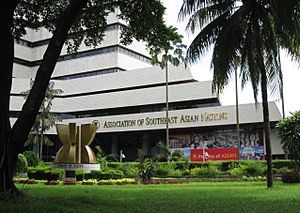
In 1997, ASEAN leaders created the ASEAN Vision 2020. This vision aimed for a peaceful and stable region, without nuclear weapons, with strong economies, and a focus on human and sustainable development. It also wanted ASEAN to play a big role in international discussions.
This vision became more detailed with the Bali Concord II in 2003. Three main parts, or "pillars," were set up for the ASEAN community:
- Political-Security Community (APSC)
- Economic Community (AEC)
- Socio-Cultural Community (ASCC)
These pillars were planned to be fully integrated by 2015.
The Political-Security Community (APSC)
The APSC aims to create a strong and safe environment within ASEAN. It works to make sure countries feel responsible for overall security and work together in a connected world.
One part of this is the ASEAN Defense Industry Collaboration (ADIC). This group helps ASEAN countries work together to develop their own defense industries. The goal is to reduce how much they rely on other countries for defense products. They also work on training and building skills for their workforce.
Another group, ASEANAPOL, helps police forces from member countries cooperate to fight crime.
The Economic Community (AEC)
The AEC aims to create a "single market" for all member countries. This means making it easier for goods, services, skilled workers, and investments to move freely between countries. The goal is to make ASEAN a highly competitive economic region that is fair and fully connected to the global economy.
To achieve this, they focus on:
- Developing human skills.
- Recognizing professional qualifications across borders.
- Working closely on economic policies.
- Improving transportation and communication links.
- Integrating industries for regional supply.
- Getting more private businesses involved.
Ensuring Food Security
ASEAN countries know how important it is to have enough food for everyone. They work to strengthen food security to keep the region stable and prosperous. This is especially important because of challenges like climate change, which can affect farming and fishing.
By making trade in food products like rice and maize easier, ASEAN aims to achieve food security together. This helps reduce the cost of food and ensures a steady supply for all member states.
The Socio-Cultural Community (ASCC)
The ASCC wants to create an ASEAN community that focuses on its people and is socially responsible. It aims for lasting unity and a common identity among ASEAN countries and their people. The goal is to build a caring and sharing society where everyone's well-being and livelihood are improved.
Key areas of focus include:
- Human development.
- Social welfare and protection.
- Fairness and rights for all.
- Protecting the environment.
- Building a shared ASEAN identity.
- Reducing differences in development between countries.
ASEAN's Economy
| Country | Population (millions) |
GDP Nominal | GDP (PPP) | ||
|---|---|---|---|---|---|
| millions of USD |
per capita USD |
millions of Int$ |
per capita Int$ |
||
| 279.965 | 1,430,000 2025f) | 5,030 | 5,010,000 | 17,610 | |
| 5.938 | 564,770 2025f) | 92,930 | 952,640 | 156,760 | |
| 65.975 | 546,220 2025f) | 7,770 | 1,850,000 | 26,320 | |
| 114.161 | 497,500 2025f) | 4,350 | 1,480,000 | 12,920 | |
| 100.770 | 490,970 2025f) | 4,810 | 1,790,000 | 17,689 | |
| 33.460 | 444,980 2025f) | 13,140 | 1,470,000 | 43,470 | |
| 54.506 | 64,940 2025f) | 1,180 | 326,890 | 5,920 | |
| 17.182 | 49,800 2025f) | 2,870 | 150,050 | 8,650 | |
| 7.686 | 16,320 2025f) | 2,100 | 78,850 | 10,120 | |
| 0.442 | 16,010 2025f) | 34,970 | 43,830 | 95,760 | |
| 1.355 | 2,130 2025f) | 1,490 | 6,970 | 4,920 | |
| 684.376 | 4,076,690 | 5,957 | 13,152,260 | 19,218 | |
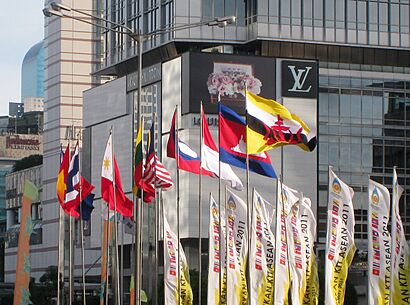
ASEAN aims for strong economic integration, creating a single market. From 1989 to 2009, member countries saw economic growth between 3.8% and 7% each year. This was faster than many other regions.
The ASEAN Free Trade Area (AFTA), started in 1992, helps goods move freely between member countries by reducing taxes on imports. This makes products cheaper and helps businesses grow. ASEAN's goal is to have zero import taxes between member states by 2016.
Experts believe that ASEAN could become the world's fourth-largest economy by 2030.
ASEAN's Internal Market: Working as One
ASEAN planned to create a single market by the end of 2015, allowing goods, services, skilled workers, and money to move freely. The ASEAN Economic Community (AEC) was formed in 2015, and they continue to work towards this goal.
Trade between ASEAN countries has been growing. In 2010, foreign investments in ASEAN doubled to US$75.8 billion. This shows that many international businesses see ASEAN as a great place to invest.
ASEAN has also made agreements for eight professions, including doctors, nurses, and engineers. This means people in these jobs can work more easily in any ASEAN country.
Six member countries (Malaysia, Vietnam, Indonesia, Philippines, Thailand, and Singapore) have also linked their stock exchanges. This helps them compete better with larger international markets.
The ASEAN Single Aviation Market (ASEAN-SAM) is another big step. It aims to create a unified aviation market in Southeast Asia. This makes air travel easier and cheaper between member states, boosting tourism, trade, and investment.
Exploring a Common Currency
ASEAN has explored the idea of an Asian Currency Unit (ACU), similar to the Euro in Europe. A common currency could make trade easier and reduce costs for businesses and travelers. It would also help keep prices stable.
However, for a common currency to work, countries need to trade more with each other and have similar economic conditions. ASEAN countries currently trade more with countries outside the region. They also have different levels of economic development. These are challenges they are working to overcome.
Free Trade Agreements
In 1992, the Common Effective Preferential Tariff (CEPT) scheme was adopted. This plan aimed to reduce tariffs (taxes on imported goods) to make the region more competitive in the global market. This led to the ASEAN Free Trade Area (AFTA).
ASEAN has also signed free trade agreements (FTAs) with many other countries and groups. These include Japan, South Korea, India, Australia, and New Zealand. These agreements help boost trade and economic growth for all involved.
One important agreement is the Regional Comprehensive Economic Partnership (RCEP). This huge trade deal involves 15 countries, covering a large part of the world's population and economy.
Tourism in ASEAN
Traveling between ASEAN countries has become much easier, thanks to visa-free travel. This means more people are exploring the region. In 2010, almost half of all tourists in ASEAN countries were from other ASEAN countries.
Tourism is a major growth area for ASEAN. In 2015, 109 million tourists visited ASEAN, a big increase from previous years. Tourism supports millions of jobs and contributes significantly to the region's economy.
ASEAN countries work together to promote the region as a single tourist destination. They hold events like the ASEAN Tourism Forum (ATF) every year to showcase their diverse cultures and attractions.
ASEAN's Global Connections
ASEAN has many friends and partners around the world. It holds ASEAN Summits, where leaders from member countries meet to discuss regional issues. They also meet with leaders from other countries to build relationships and talk about international matters. The first summit was in Bali in 1976. Since 2008, summits are held twice a year.
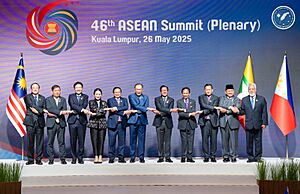
ASEAN is a key partner for many organizations, including the Shanghai Cooperation Organisation. It also has strong ties with China, working together on economy, security, education, and more. Australia and New Zealand also see ASEAN as a very important partner.
ASEAN also leads the East Asia Summit (EAS), a forum where leaders from 18 countries in the East Asian region meet. This includes China, Japan, South Korea, India, Australia, New Zealand, the United States, and Russia. They discuss trade, energy, and security, working towards building a stronger East Asian community.
Addressing Disagreements and Challenges
South China Sea Discussions
The South China Sea has seen some disagreements over land and resources. Several ASEAN countries, along with China and Taiwan, have overlapping claims. ASEAN works to encourage peaceful discussions and solutions to these issues.
Bilateral Disputes
Sometimes, there have been disagreements between individual ASEAN member states, such as border disputes between Cambodia and Thailand, or Cambodia and Vietnam. ASEAN encourages peaceful talks to resolve these issues. For example, ASEAN played a big role in the peace process for Cambodia in the 1980s, leading to an agreement in 1991.
Working with Other Regional Groups
ASEAN Plus Three
In 1997, the ASEAN Plus Three group was created. This includes ASEAN members plus China, Japan, and South Korea. This group helps coordinate cooperation on many issues, from finance and trade to disaster management and cultural exchange. It played a key role in bringing financial stability to Asia after the 1997 Asian financial crisis.
ASEAN Plus Six
Building on ASEAN Plus Three, the even larger East Asia Summit (EAS) includes ASEAN, China, Japan, South Korea, plus India, Australia, and New Zealand. This group is very important for the economic, political, and social future of the Asia–Pacific region. They are working on a free-trade agreement called the Regional Comprehensive Economic Partnership (RCEP).
Protecting the Environment in ASEAN
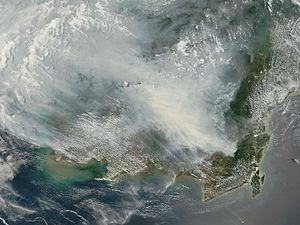
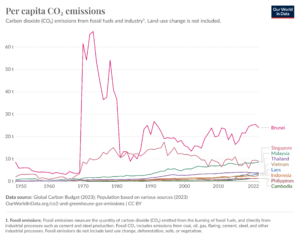
ASEAN countries have been working on environmental agreements. One important agreement is the ASEAN Agreement on Transboundary Haze Pollution from 2002. This agreement aims to control haze (smoke and pollution) that sometimes spreads across Southeast Asia. However, haze outbreaks have continued to be a challenge.
Other environmental issues include deforestation (losing forests), plastic waste, and protecting endangered animals and plants. ASEAN is working to address these problems.
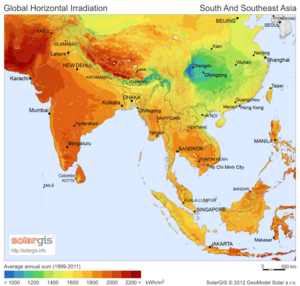
ASEAN's economy is growing very fast, but this also means more CO2 is released into the air. The region is looking for ways to grow without harming the environment. ASEAN has many opportunities for renewable energy like solar power and wind power. Countries like Vietnam are already showing how quickly solar and wind energy can be adopted.
Transitioning to Cleaner Energy
ASEAN has started to switch to cleaner energy sources. The region's energy needs are growing rapidly and are expected to triple by 2050. To meet this demand with renewable energy, significant investments are needed. This goal is achievable with the right policies.
The proposed ASEAN Power Grid could help transmit renewable energy from countries with a lot of it, like Vietnam, to others within ASEAN. This cooperation is key to unlocking the potential for green energy in Southeast Asia.
Education and Learning in ASEAN
ASEAN education ministers have agreed on four main goals for education:
- Making young people more aware of ASEAN.
- Strengthening a shared ASEAN identity through education.
- Developing human resources in education.
- Strengthening the ASEAN University Network.
The ASEAN University Network (AUN) was created in 1995. It connects universities in Southeast Asia to promote cooperation among scholars and scientists. It also helps develop academic skills and spreads information about ASEAN.
Singapore offers a special scholarship program to students from other ASEAN countries for secondary school, college, and university. Australia also offers "Australia for ASEAN" scholarships to help future leaders from ASEAN countries.
Culture and Arts in ASEAN
ASEAN organizes many cultural activities to bring the region closer together. These include sports events, educational programs, and awards for writers. Examples include the ASEAN Centre for Biodiversity and ASEAN Heritage Parks. ASEAN is known for being very diverse in its cultures, religions, and languages.
Media and Communication
ASEAN countries work together in media to help build a shared ASEAN identity. The ASEAN Committee on Culture and Information (COCI) promotes cooperation in information and culture through various projects.
The ASEAN Communication Master Plan (ACPM) helps share information about ASEAN's goals and vision with people in the region and around the world.
Some key media initiatives include:
- The ASEAN Media Portal, launched in 2007, which shares documentaries, games, and music videos about ASEAN cultures.
- The ASEAN NewsMaker Project, which trains students and teachers to create informational videos about their countries.
- The ASEAN Digital Broadcasting Meeting, where members discuss standards for digital television.
National Public Media in ASEAN
 Brunei: Radio Television Brunei
Brunei: Radio Television Brunei Cambodia: Bayon Television and National Television of Cambodia
Cambodia: Bayon Television and National Television of Cambodia Indonesia: Televisi Republik Indonesia and Radio Republik Indonesia
Indonesia: Televisi Republik Indonesia and Radio Republik Indonesia Laos: Lao National Radio and Lao National Television
Laos: Lao National Radio and Lao National Television Malaysia: Radio Televisyen Malaysia
Malaysia: Radio Televisyen Malaysia Myanmar: Myanmar International, Myanmar National Television and Myanmar Radio and Television
Myanmar: Myanmar International, Myanmar National Television and Myanmar Radio and Television Philippines: People's Television Network, Radio Philippines Network, Intercontinental Broadcasting Corporation and Presidential Broadcast Service
Philippines: People's Television Network, Radio Philippines Network, Intercontinental Broadcasting Corporation and Presidential Broadcast Service Singapore: Mediacorp
Singapore: Mediacorp Thailand: MCOT, National Broadcasting Services of Thailand, Radio Thailand, Royal Thai Army Radio and Television Station and Thai Public Broadcasting Service
Thailand: MCOT, National Broadcasting Services of Thailand, Radio Thailand, Royal Thai Army Radio and Television Station and Thai Public Broadcasting Service East Timor: Radio-Televisão Timor Leste
East Timor: Radio-Televisão Timor Leste Vietnam: Ho Chi Minh City Television, Vietnam Television and Voice of Vietnam
Vietnam: Ho Chi Minh City Television, Vietnam Television and Voice of Vietnam
Music of ASEAN
Music is an important part of ASEAN. Many songs have been written for the alliance, including:
- "The ASEAN Way", the official anthem.
- "ASEAN Song of Unity" or "ASEAN Hymn".
- "Let Us Move Ahead".
- "ASEAN Rise", for ASEAN's 40th anniversary.
- "ASEAN Spirit", for ASEAN's 50th anniversary.
Sports in ASEAN
The main sports event for ASEAN is the Southeast Asian Games, held every two years. Athletes from all member states, plus Timor-Leste, compete.
Major Sports Events
- SEA Games
- ASEAN University Games
- ASEAN School Games
- ASEAN Para Games
Championship Events
ASEAN also hosts many championship events in different sports, such as:
- Southeast Asian Football Championship
- Southeast Asian Basketball Championship
- Southeast Asian Shooting Championship
- Southeast Asian Volleyball Championship (SEA V.League)
- Southeast Asian Badminton Championship
- Southeast Asian Esports Championship
Security and Safety in ASEAN
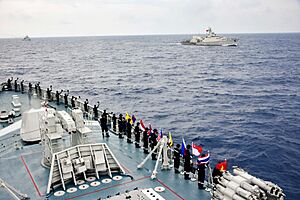
ASEAN is a key place for discussing security issues. Its main goal is to create understanding and cooperation among member states to deal with all kinds of threats and challenges. ASEAN uses a cooperative approach, building trust and openness to reduce tension and conflict.
Keeping Sea Routes Safe
Keeping the seas safe from piracy, especially in places like the Strait of Malacca, is a big challenge. ASEAN members work together to coordinate actions and ensure the security of important shipping routes. They have created plans like the Maritime Security Plan of Action to improve law enforcement and cooperation at sea.
However, because some countries have disagreements over sea borders, it can be tricky to get everyone to agree on joint operations. Despite these challenges, ASEAN members continue to push for greater cooperation to protect their economies and security.
Future Security Goals
ASEAN faces other important issues, such as ensuring fairness and good governance across the region. While there are challenges, ASEAN aims to improve accountability and address concerns about human rights.
The navies of ASEAN member countries participate in the ASEAN Multilateral Naval Exercise, or AMNEX. These exercises help them practice working together and improve their ability to respond to security challenges at sea.
Images for kids
-
Southeast Asian carrier AirAsia, featuring the "Truly ASEAN" tagline to promote regional tourism.
See also
 In Spanish: Asociación de Naciones de Asia Sudoriental para niños
In Spanish: Asociación de Naciones de Asia Sudoriental para niños
- ASEAN Smart Cities Network
- ASEAN Commission on the Promotion and Protection of the Rights of Women
- ASEAN Common Time
- ASEAN-India Car Rally 2012
- ASEAN Sculpture Garden
- Asian Monetary Unit
- Asia Pacific Forum
- Blue card system – ASEAN motor insurance scheme
- Comprehensive Economic Partnership for East Asia
- Congress of Southeast Asian Librarians
- List of ASEAN countries by GDP (nominal)
- List of country groupings
- List of the largest trading partners of the ASEAN
- List of multilateral free-trade agreements
- Mekong-Ganga Cooperation
- Pan-Asianism
- Regional Comprehensive Economic Partnership
- Southeast Asia Treaty Organisation
- ASEAN Power Grid




